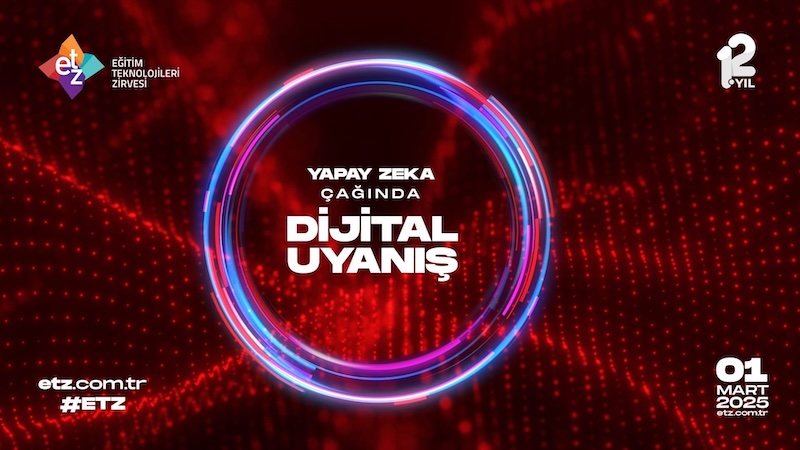A Reflection on Education Technology Summit
by Gökçe Dülgerci, Metin Çırpan and Engin Kaça
Held at the Radisson Blu in Şişli on March 1st, 2025, the fifth Education Technology Summit, summit aimed high with its promise of a "Digital Awakening." Unfortunately, despite the hype and high expectations, organizational hiccups diminished the overall experience, but there still were a few learning points and thought-provoking ideas in some of the sessions.
Adobe Express: Creativity with Productive Artificial Intelligence for Education: Güner Güler Dalkıran (Engin Kaça)
In her session, Güner Güler Dalkıran introduced the capabilities of Adobe Express that educators can make use of. Adobe Express is a content creation tool that can be used to develop different types of media for a wide range of purposes: These include graphics and visual aids, videos, voice-driven character animations, websites and presentations.
The system uses AI to generate content based on Adobe Stock “assets” (stock images, templates, any design element that you can use…). The program allows you to manipulate these assets with its following capabilities:
● Text to image: Converts text descriptions into visuals
● Generative fill: Allows modification of images
● Text templates: Offers customizable templates
● Text effects: Provides text design options
Templates are conveniently categorized by grade level and subject areas. Some use cases of the system in our context at School of Languages is to create:
Visual Materials
The text-to-image functionality can be used to create illustrations for different purposes.
Presentations
The presentation tools can be used for classroom instruction.
Audio-Visual Content
The voice animation feature allows users to:
● Select character avatars
● Record audio
● Create dialogues
● Develop listening materials
Web Content
Users can build websites for sharing resources and student work.
Video Projects
Students can create video content to practice:
● Information presentation
● Instructional language
● Interview techniques
● Narrative skills
Overall, Adobe Express represents one option among many digital tools available to us educators. Its functionality may be useful depending on the specific teaching/learning situation and the time you are prepared to invest in creating the materials using the program. I should also note that some of the features and “assets” are only available in the premium version.
The New Trend of the Digital Age: Micro Learning: Kerim Kırpat (Metin Çırpan)
In his session, Kerim Kırpat took us through the stages of creating interactive, mobile-friendly microlearning activities through the app TipStory. The platform allows educators to create, share, and report short courses quickly and easily. It is user-friendly and aims to make the process of developing micro-courses as efficient as possible.
Below are some tips and benefits of leveraging TipStory in teaching and learning:
Start with Clear Objectives: Define what you want your students to learn from each microlearning activity. Clear objectives will guide the content creation process and ensure that the activities are focused and effective.
Leverage Interactivity: Use the interactive features of TipStory.io to engage your students. Incorporate quizzes, polls, and interactive scenarios to make the learning experience more dynamic and engaging.
Keep it Concise: Microlearning is all about delivering bite-sized content. Keep your lessons short and to the point, focusing on one key concept at a time. This helps students retain information better.
Use Multimedia: Incorporate images, videos, and audio clips to make your content more engaging. Multimedia elements can help illustrate complex concepts and keep students interested.
Optimized for Mobile: TipStory.io is designed to be mobile-friendly.
Track Progress: Use TipStory.io's reporting features to track your students' progress.
Encourage Collaboration: Create activities that encourage students to work together. Collaborative learning can enhance understanding and make the learning experience more enjoyable.
Provide Feedback: Give timely and constructive feedback on students' performance. This helps them understand their strengths and areas for improvement.
Overall, TipStory.io is a valuable addition to the digital learning landscape, particularly for English language schools looking to enhance their teaching methods. Its ease of use, mobile-friendly design, and focus on interactivity make it an ideal choice for creating engaging microlearning activities. By leveraging this tool, educators can provide a more dynamic and accessible learning experience for their students.
"Artificial Forms of Natural Intelligence": Soner Yıldırım (Gökçe Dülgerci)
In his speech, Prof. Dr. Soner Yıldırım from Middle East Technical University (METU) raised concerns about the growing influence of artificial intelligence (AI) in education. He argued that while AI provides significant advantages, particularly for individuals with special educational needs or physical disabilities, its overuse can lead to superficial learning and a generation of mediocre thinkers.
The Risks of AI in Education
Prof. Yıldırım warned that relying too much on AI could diminish critical thinking and creativity among students. Since AI-generated responses often offer quick, uniform answers, students may stop engaging in deeper analytical thinking. This could lead to a "copy-paste" culture, where learners depend on AI rather than developing their own problem-solving skills.
Technology's Limited Impact in Education
He pointed out that while technology has transformed industries like business and manufacturing, its impact on classroom learning has been far less profound. Education is a complex process influenced by many factors beyond just access to information. Unlike structured tasks in professional fields, learning requires interaction, discussion, and cognitive effort, which AI alone cannot fully replace.
The Need for a Balanced Approach
Prof. Yıldırım emphasized that AI should be seen as a supportive tool rather than a replacement for traditional learning methods. While AI can assist with repetitive tasks, accessibility, and personalized learning, it must be integrated thoughtfully to ensure students still engage in deep learning, creativity, and independent thinking.
Final Thoughts
In conclusion, Prof. Dr. Yıldırım called for a more balanced approach to AI in education. While acknowledging its benefits, he stressed that human intelligence, curiosity, and problem-solving abilities must remain at the core of learning. Otherwise, we risk creating a generation that relies on AI for answers rather than developing their own intellectual capabilities.

